Are you planning to remodel your indoor space with some stunning purple hues?
The purple perennials go beyond the fundamental beauty standards. Their warm, vibrant colors enhance your space, creating a sense of luxury and creativity.
Thus, purple flowering plants make a good choice for those seeking a gorgeous in-home garden with minimal upkeep and an emphasized center point.
So if you also want to give your house a vibrant makeover, stick around till the end and get detailed guidance about growing purple plants along with a care guide.
Purple Plants: Brief Overview
The purple plants category prominently features beloved plants like lavender, lilac, iris, hyacinth, wisteria, crocus, verbena, petunia, and more. These plants fall under the popular purple perennials, celebrated for their rich, versatile shade and timeless elegance in the garden.
Additionally, the color ‘Purple’ represents royalty, luxury, power, nobility, and high status. This makes it one of the finest options for your home, enhancing the ambiance while offering profound significance and symbolism.
Care and Maintenance Guide for Purple Perennials Plants
Before welcoming the purple perennials into your home, you must know their precise care and maintenance requirements to ensure healthy growth. Though these plants are considered the epitome of low maintenance, here are a few things you need to know.
- The most crucial aspect of growing a perennial plant is its light temperament. Perennials thrive beautifully in full sunlight, but some exceptions, such as carnation plants, can also be placed indoors.
- Purple plants grow fully and lushly in well-drained or fertile soil, so make sure to make your potting mix according to the specifications required.
- These plants require a steady water supply for balanced growth. Moreover, overwatering can impact their lifespan, so water them according to the recommended quantity.
- The outdoor environment plays a vital role in the healthy growth of purple flower bush, so they generally require warm temperatures between 20 and 25 °C.
- Purple plants don’t require additional fertilizers; diluted liquid organic fertilizer during the initial growing stage could help make them healthier.
Different Varieties of Purple Perennials Suitable for Your Home
We know that choosing the perfect floral arrangements for your home can be exhausting—that’s why we are here to help you halt your quest! Follow along to learn about 21 purple perennials that are best suited for your space. Let’s examine them one by one.
Verbena
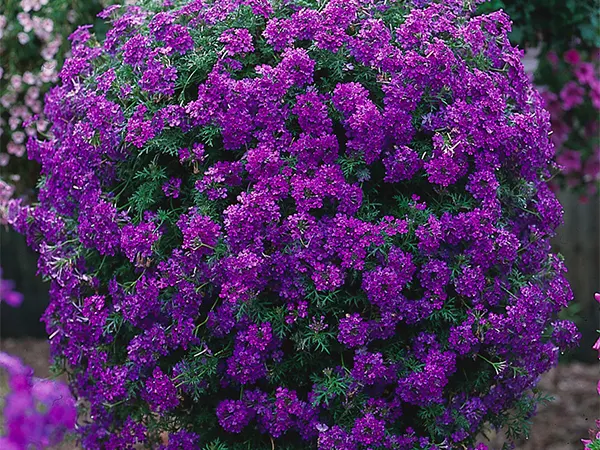
Verbena, popularly known as Verbena officinalis, is an evergreen flowering plant known for its small, tubular five petals in vibrant colors. It grows up to
3 inches (ca. 8 cm) and thrives beautifully in full sunlight, making it an excellent ornamental plant for your outer space.
| Other Name | Verbena Officinalis |
| USDA Growing Zone | 8-11 |
| Sun Exposure | Full sun (8 hrs a day) |
| Soil | Average well-drained soil |
| Plant Size | 3-5 feet tall |
| Native | Americas and Asia |
Lavender
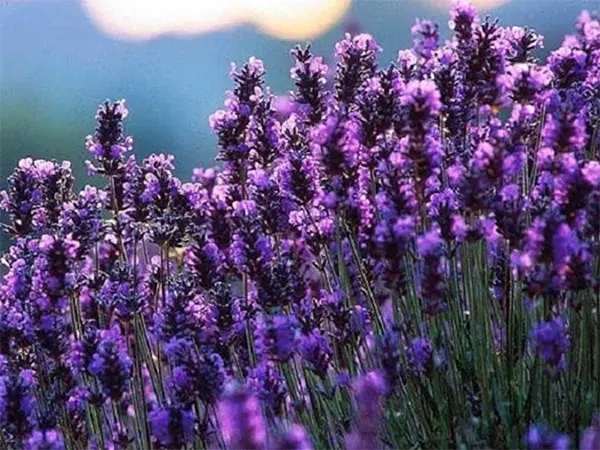
Lavender, scientifically known as Lavandula angustifolia, is famous for its dwarf height and beautiful coloration. Because of its specifications and visual appearance, it is excellently suited for outdoor settings. Additionally, it is used as a supporting centerpiece in gifting and styling bouquets.
| Other Name | Lavandula Angustifolia |
| USDA Growing Zone | 5-10 |
| Sun Exposure | Full sun |
| Soil | Well-drained soil |
| Plant Size | 1–3 feet tall |
| Native | Mediterranean Regions |
Clematis
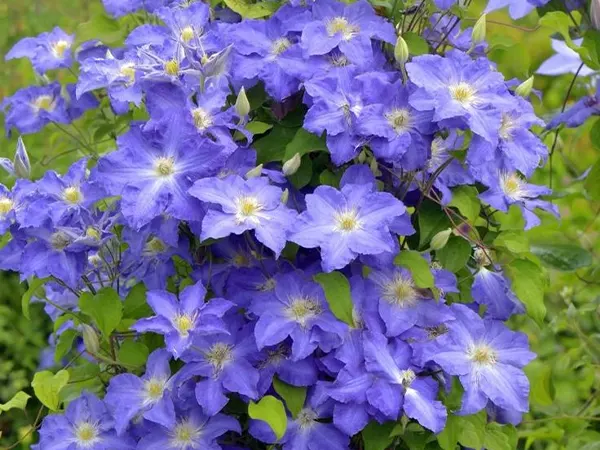
Clematis, scientifically named ‘Clematis Virginiana,’ is renowned for its trailing style and bell-shaped flowers in vibrant colors. Furthermore, it is a flowering plant that goes up to 10 ft (ca. 3 m) tall and is really suitable for uplifting your home aesthetics with welcoming colors.
| Other Name | Clematis Virginiana |
| USDA Growing Zone | 5-9 |
| Sun Exposure | Partial Sunlight |
| Soil | Well-moisture Soil |
| Plant Size | 8–12 feet tall |
| Native | Asia, Europe, and North Africa |
Bellflower
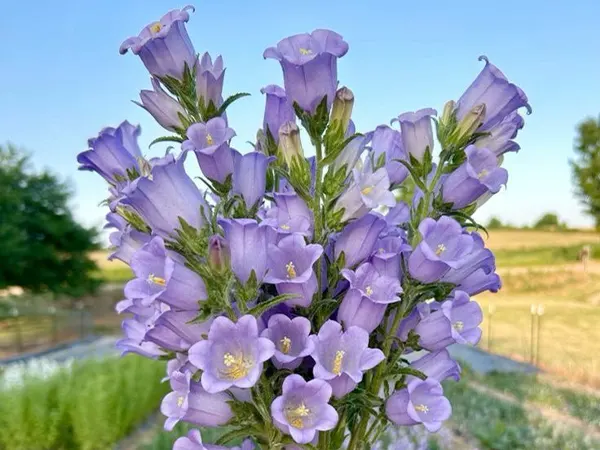
The bellflower is a purple perennial plant known for its broad crown-shaped petals and height that can reach up to 4 feet (1.22 meters). It is also commonly used in gifting and paired up in bouquet arrangements because it symbolizes gratitude, love, and warmth.
| Other Name | Campanula |
| USDA Growing Zone | 4-9 |
| Sun Exposure | Full Sun (Direct Sun-light) |
| Soil | Well-drained Soil |
| Plant Size | 2.5-4 feet tall |
| Native | Mediterranean Regions |
Dwarf Iris
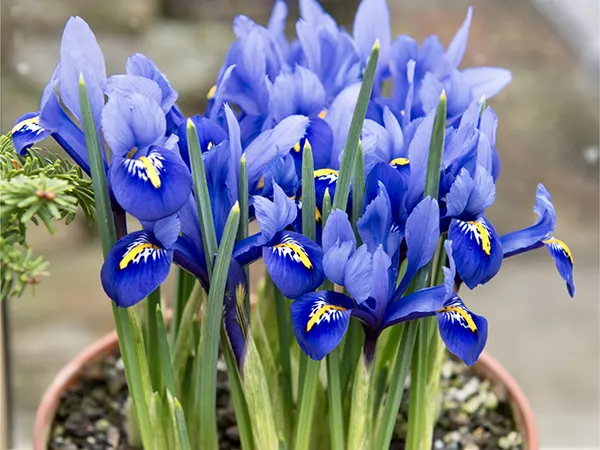
As the name hints, this purple perennial plant is prominently known for its tiny height. More importantly, it has a symbolic meaning that points to hope, renewal, and courage. So, if you want to add a meaningful plant to your home, look no further than Dwarf Iris.
| Other Name | Iris Pumila |
| USDA Growing Zone | 3-10 |
| Sun Exposure | Morning Sun (Indirect sunlight) |
| Soil | Well fertile soil |
| Plant Size | 1–3 feet tall |
| Native | Russia, Caucasus, and Northern Iran |
Ballon Flower
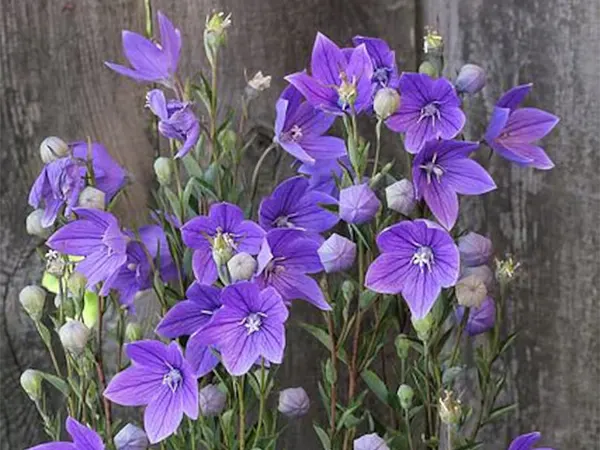
Ballon Flower, scientifically known as Platycodon grandiflorus, is famous for its five points, which represent the five elements: love, honesty, respect, truth, and gratitude. Moreover, people look forward to this plant as a gift to their loved ones or style it in their outdoor areas for cheerful sensations.
| Other Name | Platycodon Grandiflorus |
| USDA Growing Zone | 3-8 |
| Sun Exposure | Full sun (Direct sunlight) |
| Soil | Well-drained or fertile soil |
| Plant Size | 1–4 feet tall |
| Native | East Asia, China, and Japan |
Catmint
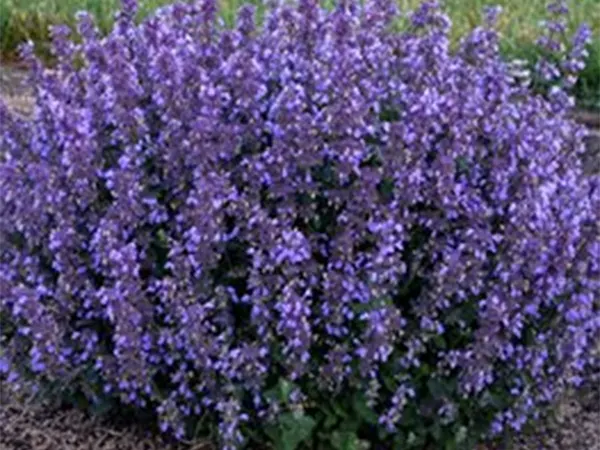
The catmint plant is much more than just a purple flower bush. In the early 1990s, it used to be a medicinal plant. Individuals use its soothing properties to treat stomach cramps, indigestion, fevers, and more. Besides this, it was a top-notch choice for garden spaces, as it thrives beautifully under full sun.
| Other Name | Nepeta Cataria |
| USDA Growing Zone | 3-8 |
| Sun Exposure | Direct sunlight |
| Soil | Well-draining soil |
| Plant Size | 1–3 feet tall |
| Native | Europe, Asia, and Africa |
Salvia
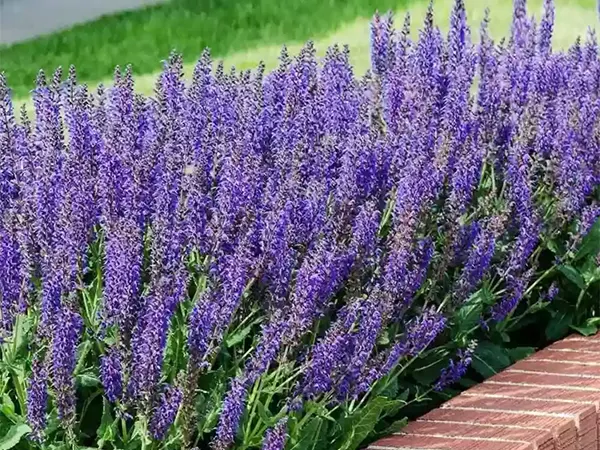
Salvia, scientifically named ‘Salvia officinalis,’ is also recognized as a ‘holy herb’ because of its contribution to medicine and religious rituals. Individuals used this purple flower bush as an antiseptic and spiritual symbol for medical practices.
| Other Name | Salvia officinalis |
| USDA Growing Zone | 3-9 |
| Sun Exposure | Full sunlight |
| Soil | Well-drained or fertile soil |
| Plant Size | 2–4 feet tall |
| Native | Central America and Mediterranean Region |
Allium
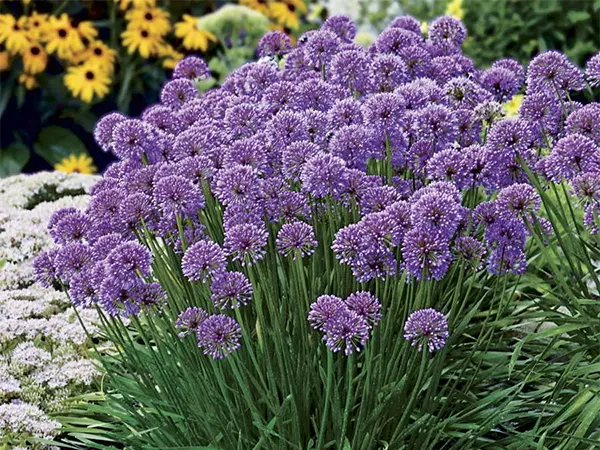
Allium is a purple flowering plant known for its large leafless stalks, linear leaves, and six-petaled flowers that grow in clusters. Because of its color, shape, and appearance, this bush with purple flowers adds a touch of elegance.
| Other Name | Allium Cepa |
| USDA Growing Zone | 3-9 |
| Sun Exposure | Full sunlight |
| Soil | Well-drained or fertile soil |
| Plant Size | 1–4 feet |
| Native | Europe and Asia |
Monkshood
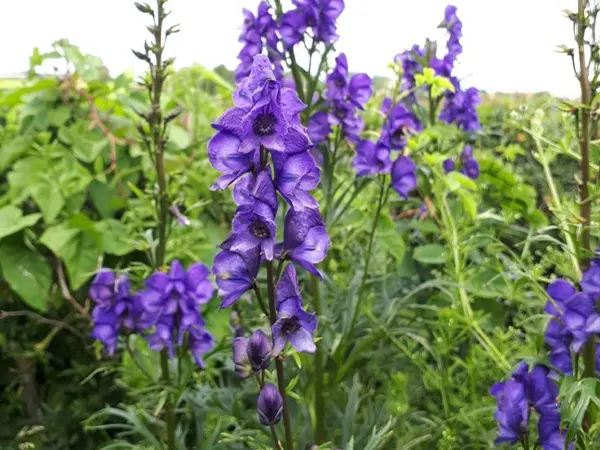
Monkshood plant is scientifically known as ‘Aconitum’ and is generally called wolfsbane perennial plant because of its purple-blue flowers that thrive beautifully in mid- to late summers. Apart from this, it looks pretty similar to the trumpet-shaped mandevilla plant.
| Other Name | Aconitum |
| USDA Growing Zone | 3-7 |
| Sun Exposure | Partial or Full Sunlight |
| Soil | Well-moist or drained soil |
| Plant Size | 2–4 feet tall |
| Native | Central and Western Europe |
Anemone
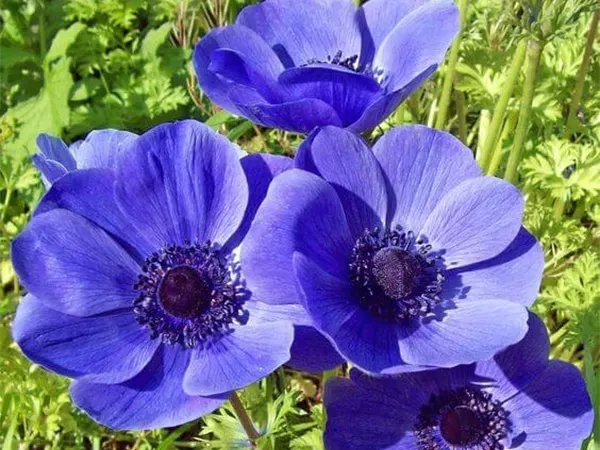
Anemone, commonly known in the botanical community as ‘Windflower,’ is a purple perennial with attractive purplish basal leaves and long leaf stems. Its benefits go beyond its beauty, and it serves as a vital nectar source for pollinators.
| Other Name | Anemone Coronaria |
| USDA Growing Zone | 7-8 |
| Sun Exposure | Partial Sunlight |
| Soil | Well-drained soil |
| Plant Size | 1–3 feet tall |
| Native | Asia, North America, and Africa |
Bittersweet Nightshade
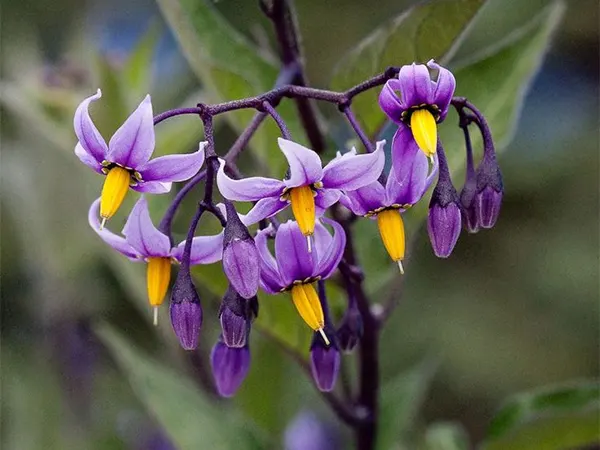
Bittersweet Nightshade is a popular purple flower shrub; its lower stems are woody, and the upper stems are herbaceous that renew yearly. Its leaves are the main centerpiece, as they are dark green and purplish, which makes it exceptionally beautiful among the other flowering plants.
| Other Name | Solanum Dulcamara |
| USDA Growing Zone | 4-8 |
| Sun Exposure | Medium to Partial Shade |
| Soil | Slightly moist soil |
| Plant Size | Up to 5 feet tall |
| Native | Europe and Asia |
Wild Indigo
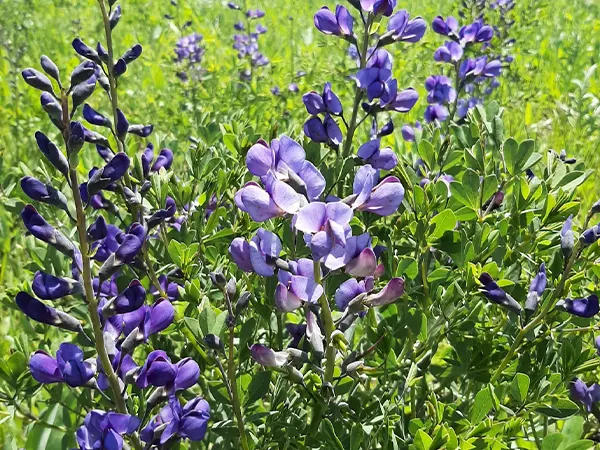
Wild Indigo, scientifically known as Baptisia bracteate, is a deep-rooted perennial bush with branched and stout stems up to 3–4 feet in height. It initially looks like a stem but becomes shrubby after blooming.
| Other Name | Baptisia Bracteate |
| USDA Growing Zone | 4-8 |
| Sun Exposure | Full sunlight |
| Soil | Slightly acidic soil |
| Plant Size | 3 to 4 feet |
| Native | Midwest of North America |
Bell Heather
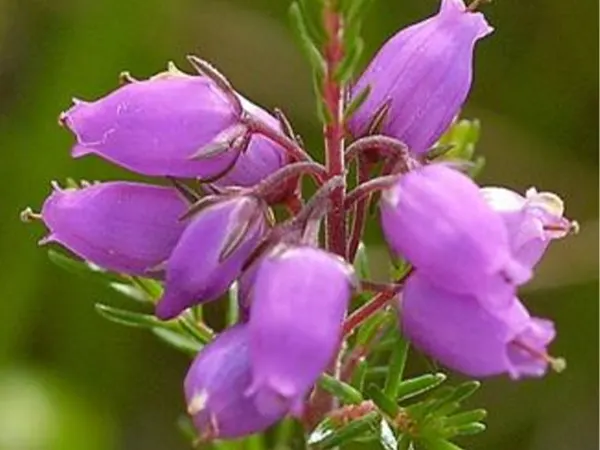
Bell Heather, scientifically known as Erica cinerea, is a low-maintenance evergreen shrub with bell-shaped flowers. It is an extremely popular choice among anthophilous because of its dark purple-pinkish flowers and needle-like leaves. In addition to its beauty, it is essential for bees, butterflies, and other insects.
| Other Name | Erica Cinerea |
| USDA Growing Zone | 5-8 |
| Sun Exposure | Full sunlight |
| Soil | Acidic soil |
| Plant Size | 2–4 feet tall |
| Native | Western and Central Europe |
Blue-Eyed Grass
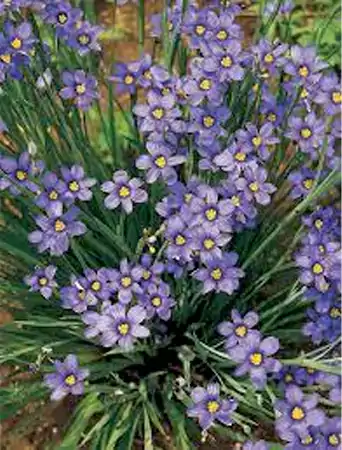
Blue-eyed grass plant, commonly known as ‘Sisyrinchium albidum,’ is an annual, perennial flowering plant with delicate flowers with sepals and petals that look like a showy garden iris or ‘yellow-eyed non-grass.’ Additionally, this flower opens during the day and closes at night (or vice versa).
| Other Name | Sisyrinchium Albidum |
| USDA Growing Zone | 4 to 9 |
| Sun Exposure | Full Sunlight |
| Soil | Average to Poor soil |
| Plant Size | 2–3 feet tall |
| Native | North and South America |
Wild Hyacinth
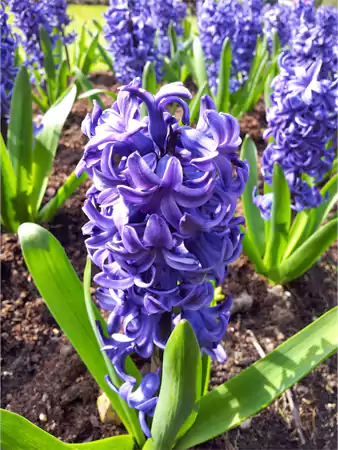
Wild hyacinth, scientifically known as ‘Camassia scilloides,’ is a perennial shrub with star-shaped flowers that bloom in spring and autumn. Additionally, it is a sub-member of the Asiatic Lily family, so you can pair it up with them to give it a proper Pinteresty aesthetic to your space.
| Other Name | Camassia Scilloides |
| USDA Growing Zone | 3-5 |
| Sun Exposure | Partial or Full sunlight |
| Soil | Rich, slightly acidic, and well-moisture soil |
| Plant Size | 1–3 feet tall |
| Native | North America, the United States, and Canada |
China Aster
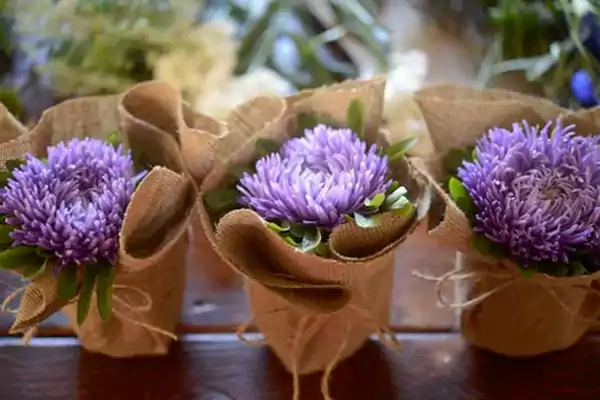
China Aster, scientifically known as Callistephus Chinensis, is a purple perennial shrub that resembles a sunflower in various colors, such as white, pink, yellow, violet, red, and purple. The resemblance is due to its belonging to the sunflower family.
| Other Name | Callistephus Chinensis |
| USDA Growing Zone | 3-8 |
| Sun Exposure | Partial Sunlight |
| Soil | Slightly acidic soil |
| Plant Size | 1–3 feet tall |
| Native | China and Korea |
Canterbury Bells
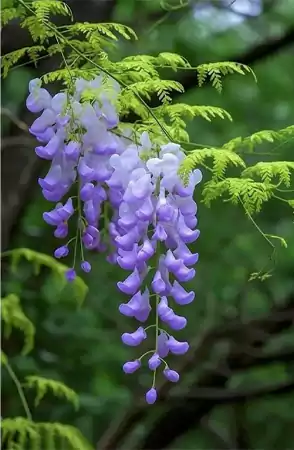
Campanula medium, commonly known as the Canterbury Bells plant, is a bell-shaped perennial flower that grows in spikes up to 2–3 feet tall. The plant’s focal point is its pungent scent, which makes it a perfect option for your home just like the Majesty Palm that cares for your both indoors or outdoors look.
| Other Name | Campanula medium |
| USDA Growing Zone | 4-10 |
| Sun Exposure | Partial shade (No direct sunlight) |
| Soil | Well-draining soil |
| Plant Size | 2-3 feet |
| Native | Southern Europe and Italy |
Carnations
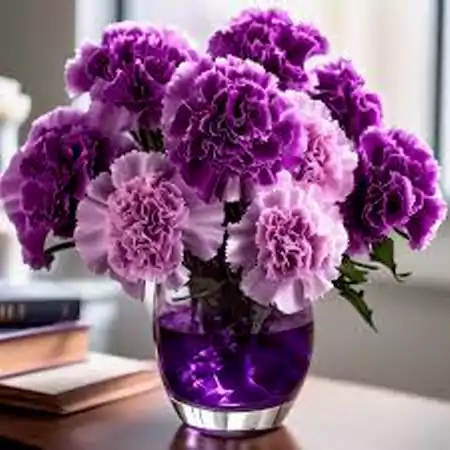
The carnation is a perennial flowering plant, usually recognized for its cotton-candy-like flower and relatively short height. It is reasonably famous among flower enthusiasts as a centerpiece of bouquets and looks visually pleasing when placed indoors.
| Other Name | Dianthus Caryophyllus |
| USDA Growing Zone | 6-10 |
| Sun Exposure | Partial shade (No direct sunlight) |
| Soil | Well-draining soil |
| Plant Size | 1–3 feet tall |
| Native | Mediterranean Region |
Alpine Betony
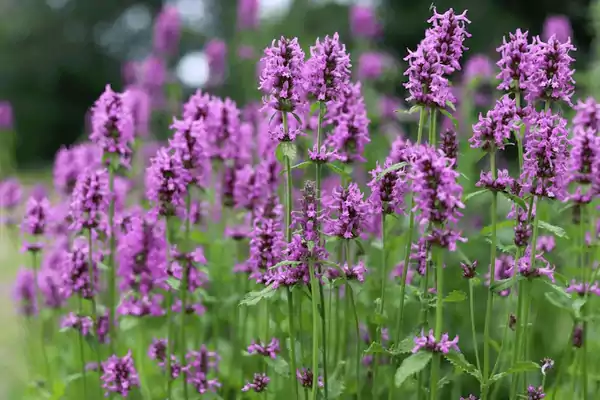
The Alpine Betony, scientifically known as ‘Stachys monitor Hummelo,’ is a low-growing perennial plant with green leaves and lilac-purple flowers. Furthermore, it is a low-maintenance purple perennial with a favorable texture and appearance that can effectively enhance the overall ambiance of the area you intend to cultivate.
| Other Name | Stachys monieri ‘Hummelo’ |
| USDA Growing Zone | 5-8 |
| Sun Exposure | Full Sunlight |
| Soil | Average drained soil |
| Plant Size | 1-3 feet tall |
| Native | Europe and Asia |
Lily of the Nile
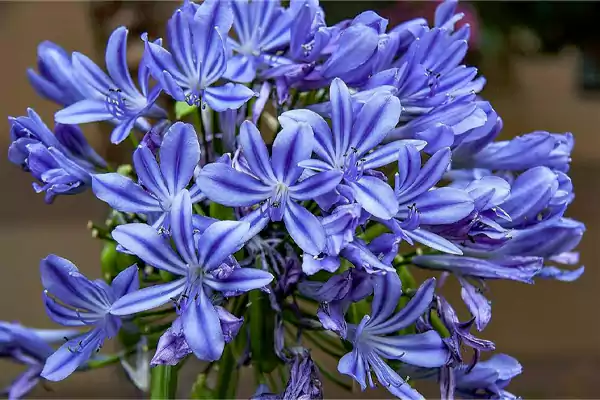
Lily of the Nile, often known as African Lily, is a flowering plant with globe-shaped clusters of funnel-like blossoms in shades of purple, lilac, and blue, with a hint of yellow and white at the center. It thrives in low or partial sunlight, making it an excellent choice for adding charm to your cozy indoor space.
| Other Name | Agapanthus Orientalis |
| USDA Growing Zone | 7-11 |
| Sun Exposure | Partial or low sun |
| Soil | Well-drained or fertile soil |
| Plant Size | 2-4 feet tall |
| Native | South Africa |
Things You Need to Take Care of While Handling Purple Plant
Purple perennials are known for being low maintenance, but you still need to take care of certain things while handling them. So, here’s a quick overview of stuff that you have to take care in order to help your plant live longer.
- As mentioned, it thrives beautifully in fertile or drained soil, but deteriorates in acidic soil conditions. So, make sure to check the PH value; it should be between 5 and 6.
- These plants are vulnerable to fungal diseases in the peak humid summer season; changing leaf colors or leaves dropping by are the standard signs.
- The purple perennials attract plants, insects, and other pests, so inspect them regularly. To expel pests, you can also use essential oil or neem-based oil.
- Purple plants are slightly poisonous, so keep your pets and children away from them to ensure their safety.
Additional Tips to Incorporate Purple Flowering Plants Into Your Home to Elevate the Aesthetics
These plants immediately uplift the vibe and bring a sense of royalty and exquisiteness to your space. But do you know how to incorporate them to make your space look like a Pinterest paradise?
Many approaches exist, but here are some personalized tips from our end to make it more eye-alluring.
- Allocate specific time to analyze the flowers. For instance, the purple flower bush, such as the catmint plant, thrives exceptionally outdoors. Meanwhile, purple plants, such as dwarf iris, can be placed indoors in the living room. So, to avoid havoc later, ensure you’re putting up plants according to their specifications.
- Another thing is color theory; many people overlook this, but you should precisely know what goes with the primary plant. For example, you should pair the purple perennial plants with pastel colors to give them a contrasting look.
- No matter how tiny your outdoor space is, make it beautiful. To do this, use a hanging garden: grab some stacks, hang them on the wall, and pair purple shrubs with different plants.
- As noted, some purple perennials thrive beautifully indoors, so grab your preferred plants and arrange them in the hall. Place them in the center of the table or the corner of your living room.
- Bored with the regular walls? Grab a purple clematis perennial and let it climb one corner of your wall as much as this plant wants to. The beautiful purple color will cherish the dull corner of your house with cheerful energy.
Summing Up!
The purple plants extend beyond the beauty standards; they represent new growth, beginnings, trust, admiration, and a warm vibe to cheer up and add bright enthusiasm to your garden area.
Furthermore, follow the above recommendations, create an aesthetically pleasing balcony with purple perennials, and achieve a ‘Pinterest paradise.’ As, having a pleasing balcony garden with a coffee in one hand is no longer a distant dream.
What do purple plants symbolize?
Purple plants symbolize royalty, trust, warmth, love, respect, and more. They also represent admiration, so it is considered a top gift choice.
Are purple perennials indoor plants?
No, it depends on the plant. For instance, ‘Balloon Flower and Canterbury Bells’ are purple flower bushes that best suit outdoor settings.
What are the benefits of purple plants?
As mentioned, purple plants were used in medicines and regional practices in the early 1990s.
